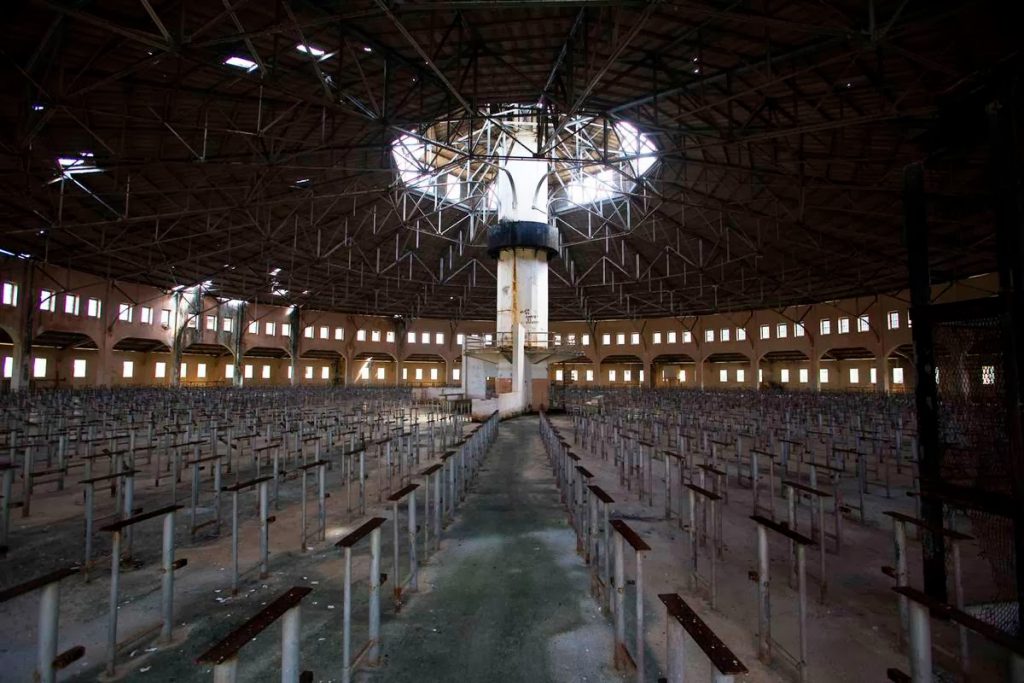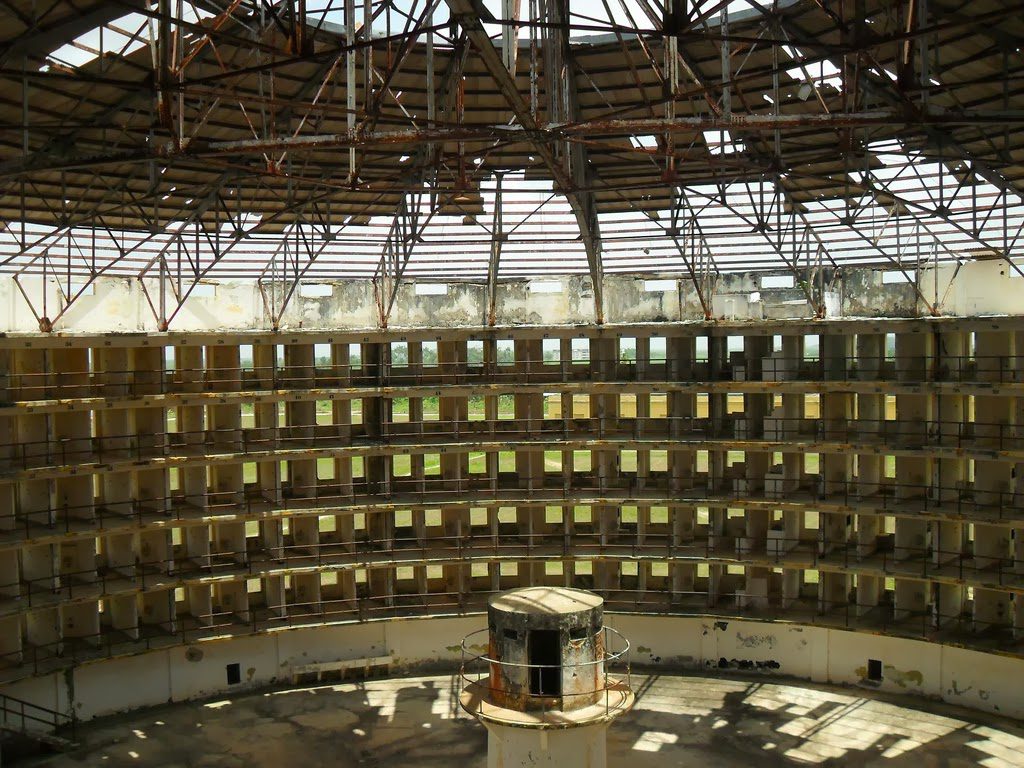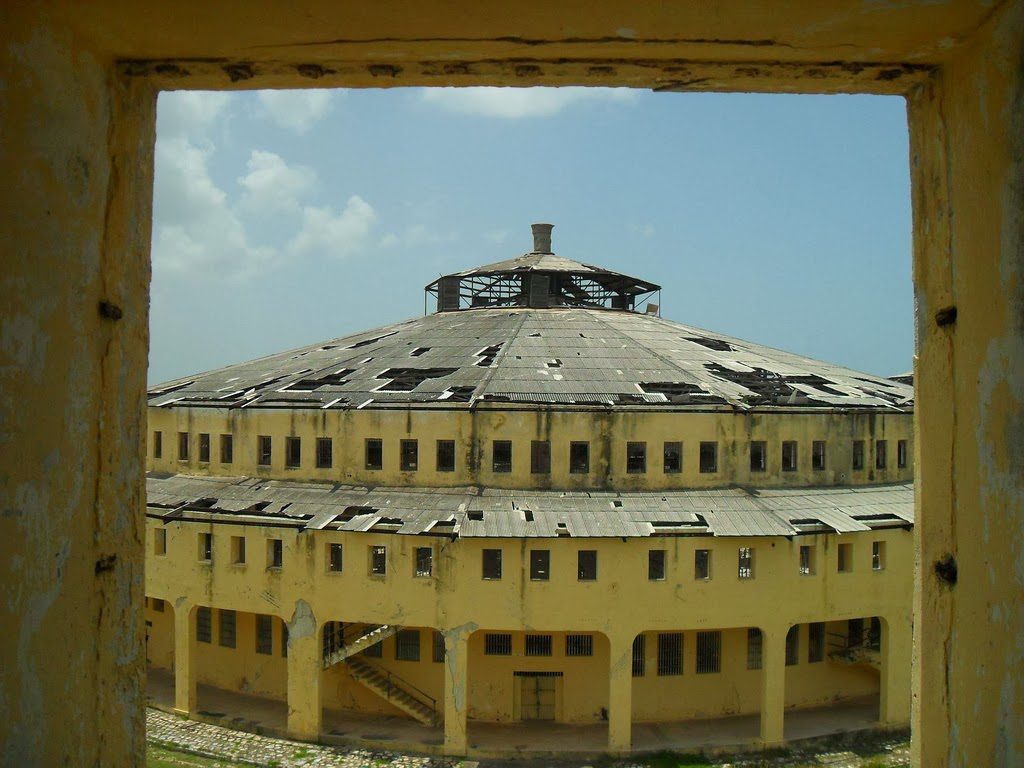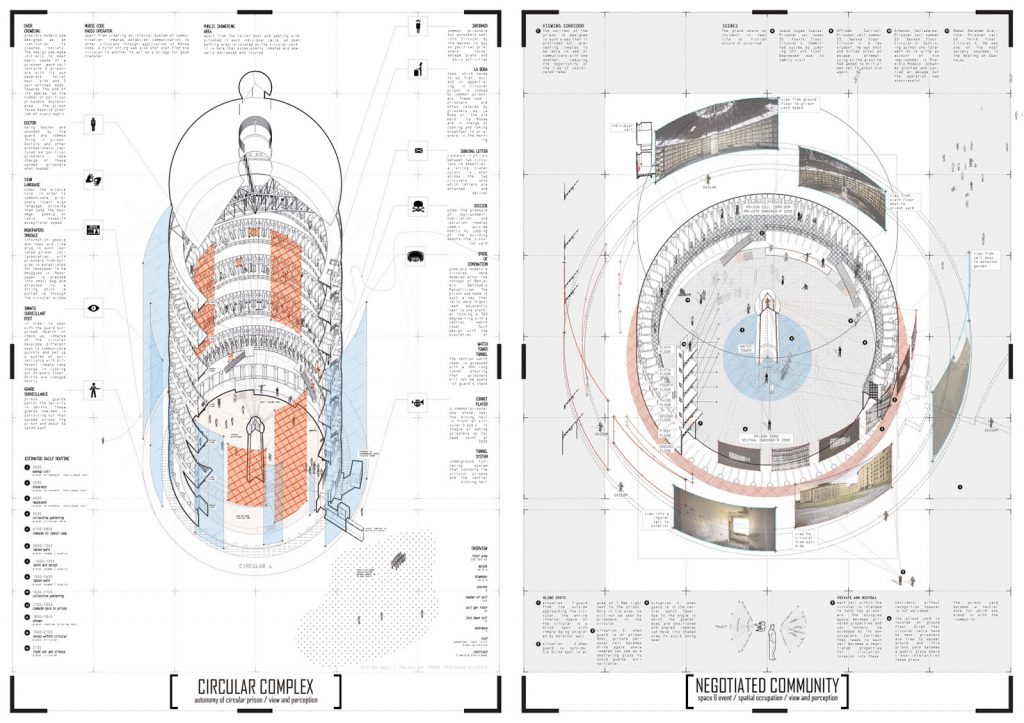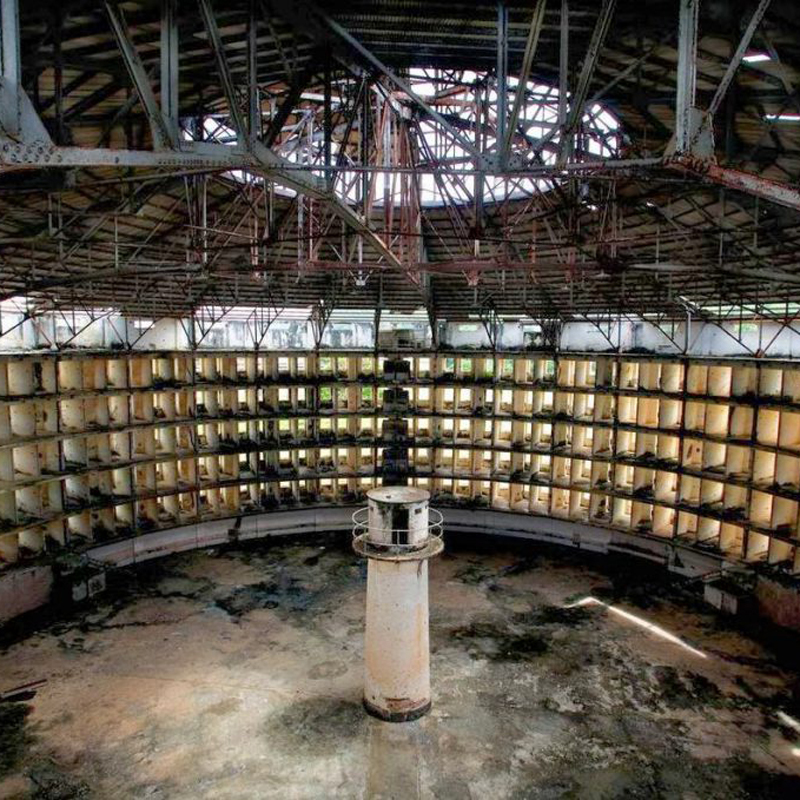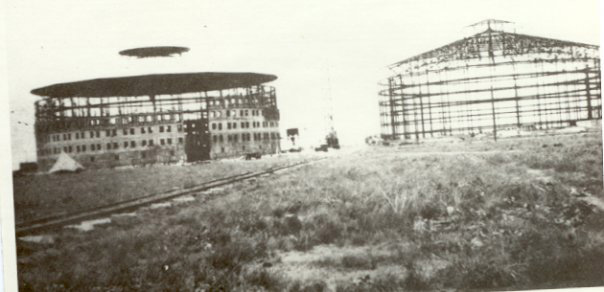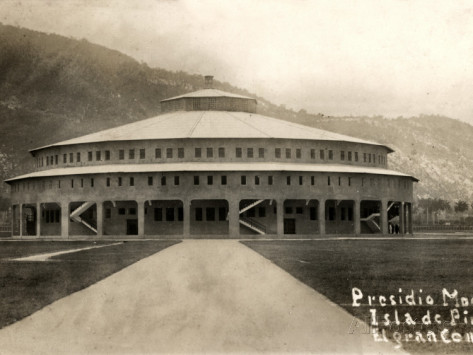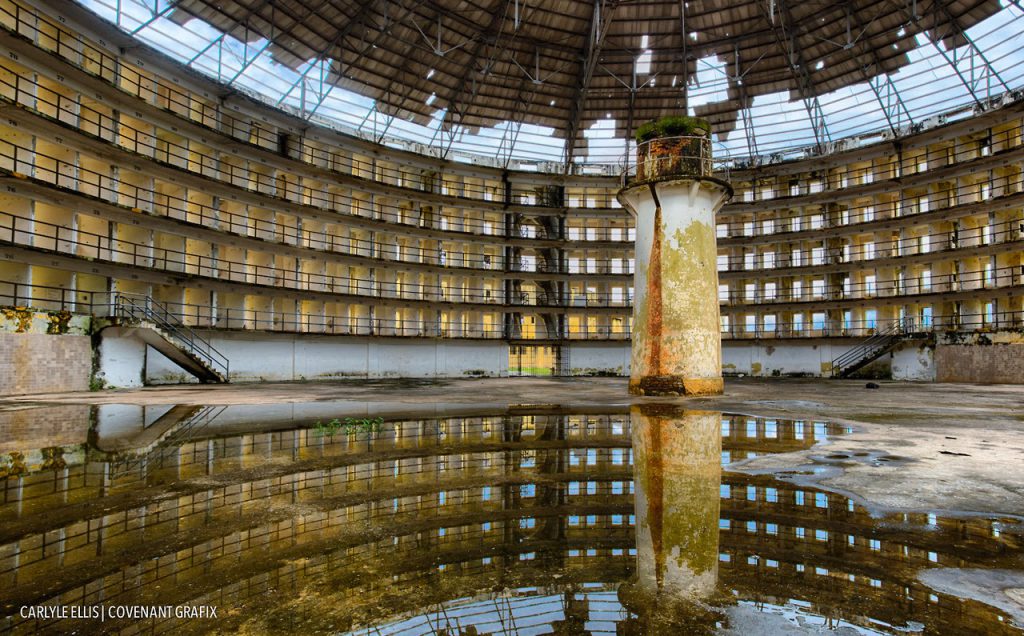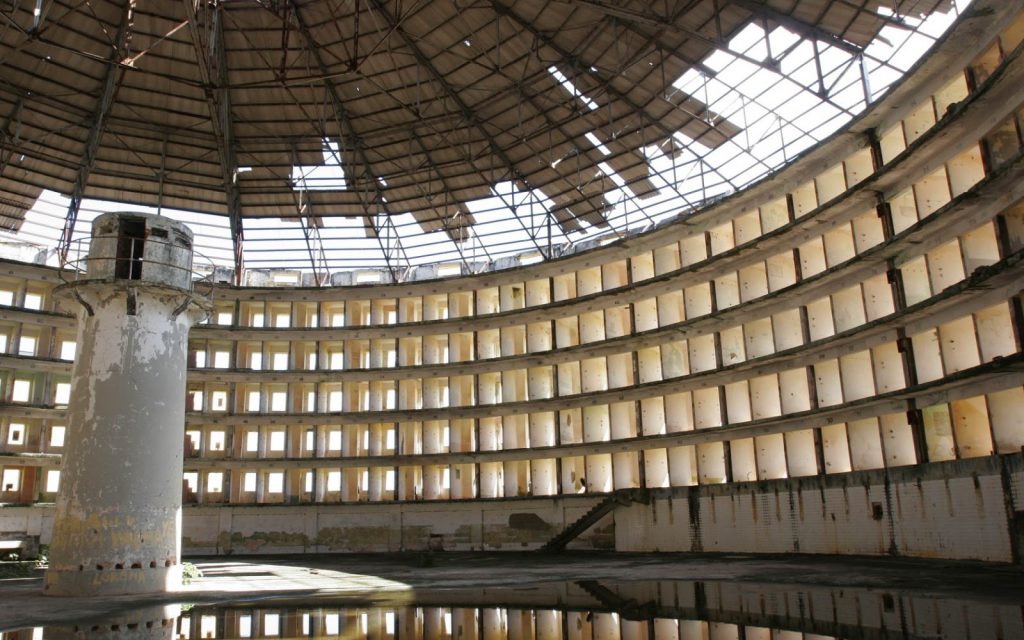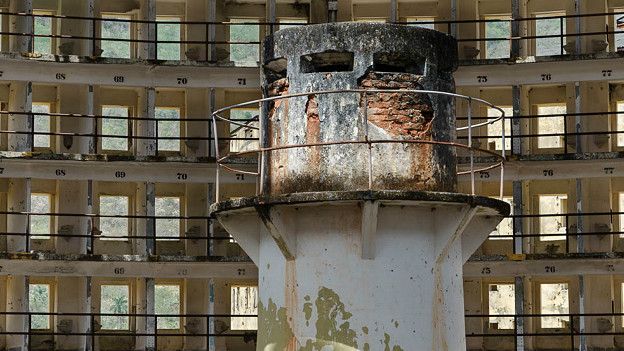The Panopticon is a type of institutional building designed by the English philosopher and social theorist Jeremy Bentham in the late 18th century. The concept of the design is to allow all (pan-) inmates of an institution to be observed (-opticon) by a single watchman without the inmates being able to tell whether or not they are being watched. Although it is physically impossible for the single watchman to observe all cells at once, the fact that the inmates cannot know when they are being watched means that all inmates must act as though they are watched at all times, effectively controlling their own behaviour constantly. The name is also
a reference to Panoptes from Greek mythology; he was a giant with a hundred eyes and thus was known to be a very effective watchman.
El Panóptico es un tipo de edificio institucional diseñado por el filósofo y teótico social inglés Jeremy Bentham a finales de siglo XVIII. El concepto fundamental del diseño es permitir que todos (pan) los miembros de una institución sean observados (opticon) por un solo vigilante sin que sean capaces de discernir si están siendo observados o no. Aunque es físicamente imposible que el vigilante pueda observar todas las celdas al mismo tiempo, el hecho de que los miembros no sepan cuándo están siendo observados implica que todos deban actuar como si estuvieran siendo observados continuamente. El nombre también hace referencia al Panoptes de la mitología griega, un gigante con cien ojos conocido por ser un efectivo vigilante.
 |
| Panopticon by Jeremy Bentham
|
The design consists of a circular structure with an “inspection house” at its centre, from which the manager or staff of the institution are able to watch the inmates, who are stationed around the perimeter. Bentham conceived the basic plan as being equally applicable to hospitals, schools, sanatoriums, and asylums, but he devoted most of his efforts to developing a design for a Panopticon prison. It is his prison that is now most widely meant by the term “panopticon”.Bentham himself described the Panopticon as “a new mode of obtaining power of mind over mind, in a quantity hitherto without example.” Elsewhere, in a letter, he described the Panopticon prison as “a mill for grinding rogues honest”.
El diseño consiste en una estructura circular con una casa de inspección en el centro, desde la cual el director de la institución puede controlar al resto de internos, instalados en el perímetro. Bentham concibió el diseño básico en planta de forma que pudiera aplicarse a hospitales, colegios, sanatorios o asilos, mostrando mayor empeño en desarrollar el programa de prisión. Bentahm describe el Panótico como “un nuevo modo de obtener una mente poder sobre otra, de una forma hasta ahora desconocida”. También como “un molino para convertir en honestos a los canallas”.

“The building circular—A cage, glazed—a glass lantern about the Size of Ranelagh—The prisoners in their cells, occupying the circumference—The officers in the
centre. By blinds and other contrivances, the inspectors concealed […] from the observation of the prisoners: hence the sentiment of a sort of omnipresence—The whole circuit reviewable with little, or if necessary without any, change of place. One station in the inspection part affording the most perfect view of every cell.”
“El edificio circular – una jaula, de vidrio – una linterna de vidrio del tamaño del Ranelagh. Los prisioneros en su celda, ocupando la circunferencia. Los oficiales, en el centro. Mediante persianas u otros inventos los inspectores se ocultan de las miradas de los prisioneros, de ahí el sentimiento de un tio de omnipresencia. Todo el circuito visible sin apenas un desplazamiento. Una estación en la parte de inspección permitiendo las más perfecta vista de cada celda.”
Jeremy Bentham

“It is polyvalent in its applications; it serves to reform prisoners, but also to treat patients, to Instruct schoolchildren, to confine the insane, to supervise workers, to put beggars and idlers to work. It is a type of location of bodies in space, of distribution of individuals in relation to one another, of hierarchical organization, of disposition of centres and channels of power, of definition of the instruments and modes of intervention of power, which can be implemented in hospitals, workshops, schools, prisons. Whenever one is dealing with a multiplicity of individuals on whom a task or a particular form of behaviour must be imposed, the panoptic schema may be used. It is – necessary modifications a part – applicable ‘to all establishments whatsoever, in which, within a space not too large to be covered or commanded by buildings, a number of persons are meant to be kept under inspection’. In each of its applications, it makes it possible to perfect the exercise of power. It does this in several ways: because it can reduce the number of those who exercise it, while increasing the number of those on whom it is exercised. Because it is possible to intervene at any moment and because the constant pressure acts even before the offences, mistakes or crimes have been committed. Because, in these conditions, its strength is that it never intervenes, it is exercised spontaneously and without noise, it constitutes a mechanism whose effects follow from one another. Because, without any physical instrument other than architecture and geometry, it acts directly on individuals; it giv es ‘power of mind overmind’. The panoptic schema makes any apparatus of power more intense: it assures its economy (in material, in personnel, in time); it assures its efficacity by its preventative character, its continuous functioning and its automatic mechanisms. It is a way of obtaining from power ‘in hitherto unexampled quantity’, ‘a great and new instrument of government .; its great excellence consists in the great strength it is capable of giving to any institution it may be thought proper to apply it to. “
“Es polivalente en sus funciones; sirve para reformar prisioneros, pero también para tratar pacientes, para instruir a escolares, confinar enfermos, supervisar trabajadores, poner a mendigos y maleantes a trabajar. Es un tipo de ubicación de cuerpos en el espacio, una distribución de individuos en relación con otros semejantes, de organización jerarquizada, de disposición de centros y canales de poder, que puede ser implementado en hospitales, talleres, escuelas o prisiones. En cualquier lugar donde alguien trate con una multiplicidad de indiviudos sobre los cuales recaiga una tarea una imposición de un determinado modo de comportamiento, el esquema panóptico podría ser utilizado. Es aplicable a cualquier lugar en cual, en el interior de un espacio no demasiado grande a ser cubierto por edificios, un número de personas debe ser custodiada. En cada una de sus aplicaciones, hace perfectamente posible el ejercicio del poder. Lo hace de diversos modos: reduciendo el número de aquellos que lo ejercen, incrementenado el número de sometidos. Hace posible intervenir en cualquier momento y actúa como medio de presión aun antes de que cualquier crimen o fallo sea cometido. En estas condiciones, su fuerza es el no intervenir nunca, el poder se ejerce de manera espontánea y sin ruido, constituye un mecanismo cuyos efectos se suceden uno detrás de otro. Sin más instrumento que la arquitectura o la geometría, actúa directamente sobre el individuo, otorga el poder de una mente sobre el resto. El esquema ponóptico hace a cualquier aparato de poder más intenso: asegura su seconomía, su eficacia por su carácter preventivo, su continuo funcionamiento y mecanismos automáticos. Es un modo de obtener poder de una forma sin precedentes, un gran y nuevo medio de gobierno; su gran excelencia consiste en fuerza de poder ser aplicada en cualquier institución.”
Michel Foucault. Discipline and Punish, 1975

The prison was built under the President-turned-dictator Gerardo Machado between 1926 and 1928. The five circular blocks, with cells constructed in tiers around central observation posts, were built with the capacity to house up to 2,500 prisoners in humane conditions.
La prisión fue construida durante la dictadura de Gerardo machado, entre 1926 y 1928. Los cinco bloques circulares, con las celdas construidas en graderíos alrededor del punto central de observación, tenían una capacidad de alojar hasta 2500 prisioneros en condiciones mínimamente dignas.

Most of the survivors of the rebel attacks on Moncada Barracks, including one attack leader, Fidel Castro, and his brother, Raul Castro, were imprisoned there, most from 1953 to 1955. After Fidel Castro’s revolutionary triumph in 1959, Presidio Modelo remained in operation. By 1961, due to the overcrowded conditions (up to 4000 prisoners at one time), it was the site of various riots and hunger strikes, especially just before the Bay of Pigs invasion, when orders were given to line the tunnels underneath the entire prison with several tons of TNT.Prominent Cuban political prisoners such as Armando Valladares, Roberto Martín Pérez, and Pedro Luis Boitel were held there at one point or another during their respective incarcerations. It was permanently closed by the government in 1967.
La mayor parte de los supervivientes de los ataques rebeldes a Moncada, incluyendo el líder, Fidel Castro, y su hermano Raúl Castro, fueron encarcelados aquí entre 1953 y 1955. Despúes del triunfo revolucionario de Fidel castro en 1959, el Presidio Modelo continuó en funcionamiento, Alrededor de 1961, debido a la situación de hacinamiento que sufrían los 4000 prisioneros del momento, tuvieron lugar distintos motines y huelgas de hambre, especialmente antes de la invasión de Bahía Cochinos, cuando se ordenó llenar los túneles subterráneos de la prisión con toneladas de TNT. Famosos prisioneros políticos cubanos como Armando Valladares, roberto Martín Pérez o Pedro Luis Botel permanecieron en algún momento aquí. La cárcel fue permanentemente clausurada por el gobierno en el año 1967.
 |
| Fidel and Raul Castro leaving Presidio Modelo at 1955 |
The prison now serves as a museum and is declared a national monument, and the old administration building now serves as a school and research center.
Actualmente sirve como museo y ha sido declarada monumento nacional.




